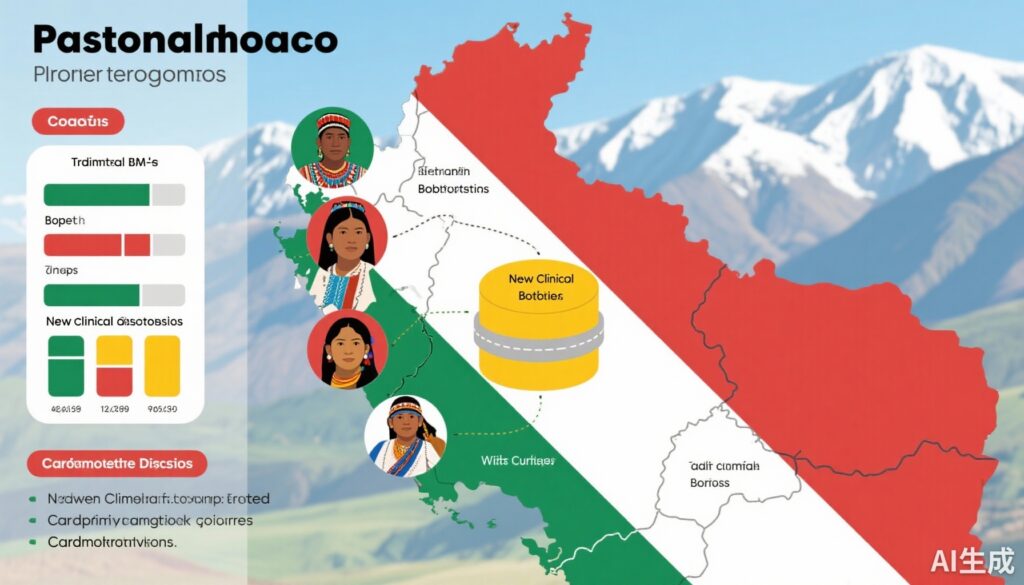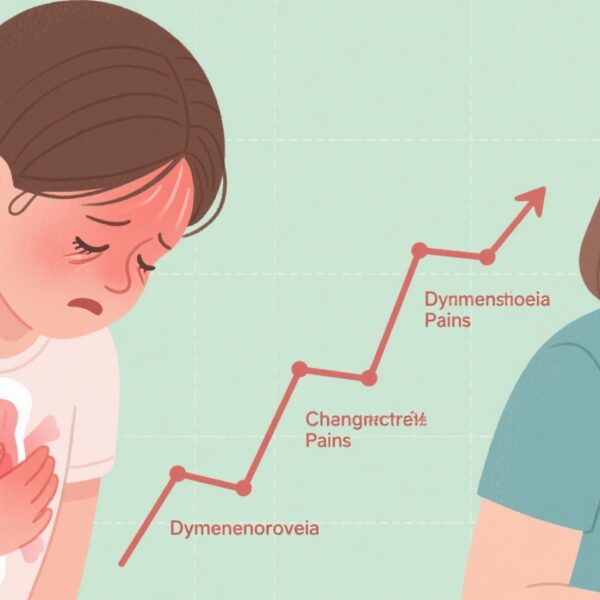Highlights
- The traditional BMI-based obesity classification substantially underestimates individuals with clinically relevant adiposity and cardiometabolic risk.
- The Lancet Diabetes & Endocrinology Commission’s new framework distinguishes preclinical obesity (excess adiposity without dysfunction) from clinical obesity (excess adiposity with cardiometabolic dysfunction), improving risk stratification.
- In a nationally representative Peruvian adult sample, up to 13.5% with normal BMI and 21% classified as overweight met clinical obesity criteria, underscoring BMI limitations.
- Ethnicity-specific reference curves revealed lower waist circumference and waist-to-height ratios among Quechua-Aymara compared to Afro-Peruvian groups, highlighting the need for regional cutoff adaptations.
Background
Obesity remains a leading global health challenge due to its association with cardiometabolic diseases including type 2 diabetes, hypertension, and cardiovascular disease. Conventional classification relies predominantly on body mass index (BMI), an easily obtained anthropometric measurement. However, BMI does not account for body fat distribution or organ dysfunction, which are critical in determining cardiometabolic risk.
Recent advances underscore the heterogeneity of obesity, where identical BMI levels may confer different risk profiles depending on fat distribution, ectopic fat deposition, and presence of metabolic dysfunction. The Lancet Diabetes & Endocrinology Commission (2023) proposed a novel framework distinguishing preclinical obesity—characterized by excess adiposity yet no clinical dysfunction—from clinical obesity, which includes excess adiposity coupled with metabolic diseases such as hypertension or diabetes. This reconceptualization aims to better target clinical interventions and inform public health policies.
In Latin America, and specifically in Andean countries like Peru, diverse ethnic groups exhibit unique anthropometrics and metabolic pathways, challenging the universal application of global obesity cutoffs. Thus, ethnicity-specific anthropometric reference values and diagnostic frameworks incorporating clinical dysfunction are needed for accurate obesity surveillance and management.
Key Content
Study Design and Population
The recent study by Guerra Valencia et al. analyzed 84,622 adults age ≥20 years from the 2021–2023 Peruvian Demographic and Health Surveys (ENDES), providing a large nationally representative sample. The cohort had a mean age of 44.1 years, with a slight female predominance (51.7%).
Obesity Classification Using New Frameworks
Clinical obesity was defined by excess adiposity determined with BMI, waist circumference (WC), or waist-to-height ratio (WHtR) cutoffs, combined with presence of clinical dysfunction (history of diabetes or hypertension). Preclinical obesity referred to excess adiposity without clinical dysfunction.
Four anthropometric criteria sets were applied: Lancet Commission guidelines, Peruvian national guidelines, International Diabetes Federation (IDF) criteria, and the Latin American Consortium of Studies in Obesity (LASO) cutoffs. Age-adjusted prevalence was estimated and stratified by sex.
Prevalence and Diagnostic Gaps Identified
The age-adjusted prevalence of clinical obesity ranged from 15.7% to 22.1%, and preclinical obesity from 28.7% to 53.8%, depending on the criteria used. Of note, 13.5% of participants with normal BMI and 21% of those classified as overweight met clinical obesity criteria, indicating significant underestimation by BMI alone.
Women exhibited the highest prevalence of preclinical obesity (33.4%–65.8%), while men had highest prevalence when IDF cutoffs were applied (41.3%). Clinical obesity prevalence was higher in women according to the Lancet Commission approach (18.7%) and Peruvian national guidelines (21.4%), whereas men had higher prevalence using LASO (16.8%) and IDF criteria (22.8%).
Ethnicity-Specific Anthropometric Reference Curves
Generalized additive models for location, scale, and shape (GAMLSS) generated ethnicity- and sex-specific reference curves for WC and WHtR. The Quechua-Aymara population demonstrated consistently lower WC and WHtR estimates at the 97th percentile compared to Afro-Peruvian and other ethnic groups in both sexes. This ethnic variability underscores the importance of calibrating obesity cutoffs to regional and ethnic-specific anthropometric standards.
Comparisons with Prior Evidence and Guidelines
Previous meta-analyses and cohort studies have demonstrated the metabolic risk associated with central obesity measures (WC, WHtR) independent of BMI, supporting the clinical utility of combined anthropometric and clinical criteria. The WHO and IDF have progressively recognized the limitations of BMI and proposed complementary measures; however, the integrated framework proposed by the Lancet Commission formalizes clinical dysfunction as a diagnostic cornerstone.
In Latin America, where indigenous populations and Afro-descendants coexist, prior studies have illustrated ethnic differences in fat distribution and metabolic disease risk, advocating for regionally adapted cutoffs—a principle validated by this Peruvian analysis.
Expert Commentary
This population-based study exemplifies a critical step toward precision medicine approaches in obesity classification, integrating anthropometry with metabolic health metrics. Reliance solely on BMI inadequately captures at-risk individuals, especially in multiethnic populations such as Peru’s.
The finding that a significant fraction of normal BMI individuals harbor clinical obesity challenges clinicians to augment screening protocols beyond BMI, incorporating WC and WHtR routinely and assessing presence of hypertension and diabetes proactively. Sex differences in prevalence highlight the potential impact of hormonal, behavioral, and sociocultural factors influencing adiposity patterns.
The use of GAMLSS models to derive ethnicity-specific anthropometric references represents methodological advancement, enabling tailored clinical thresholds that may improve diagnostic sensitivity and specificity. However, clinical implementation will require validation of these cutoffs in prospective cohorts and assessment of their predictive value for hard outcomes such as cardiovascular events.
Limitations of the study include its cross-sectional design, which precludes causal inference. Self-reported diagnoses of diabetes and hypertension may underestimate clinical dysfunction prevalence. Additionally, other emerging markers of metabolic dysfunction (e.g., dyslipidemia, inflammation) were not incorporated, which could refine phenotyping further.
From a mechanistic standpoint, central adiposity correlates more robustly than BMI with visceral fat accumulation, insulin resistance, and proinflammatory cytokine production, underscoring the biological plausibility for WC and WHtR inclusion. Ethnic differences in fat distribution may arise from genetic, environmental, and lifestyle factors, requiring adapted diagnostic algorithms.
Conclusion
This comprehensive national survey highlights that conventional BMI-based obesity classification underestimates clinically important obesity, with significant proportions of the population exhibiting clinical adiposity and cardiometabolic dysfunction despite normal or overweight BMI ranges.
Incorporating waist circumference, waist-to-height ratio, and evidence of clinical dysfunction into diagnostic frameworks significantly enhances identification of at-risk individuals, particularly in multiethnic populations. Ethnicity- and sex-specific reference curves provide critical tools for tailoring public health strategies and clinical interventions.
Future research should prospectively validate these novel definitions, investigate their prognostic impact on cardiovascular and metabolic outcomes, and evaluate interventions targeting preclinical and clinical obesity phenotypes. Policymakers and clinicians in Peru and similar LMIC settings should embrace refined obesity diagnostic frameworks to better address the obesity epidemic’s complexity and heterogeneity.
References
- Guerra Valencia J, Hernández-Vásquez A, Mayta-Tristán P, Saavedra-Garcia L, Vargas-Fernández R. The new definition of obesity: an analysis of a population-based survey in an Andean country. Lancet Reg Health Am. 2025 Aug 29;50:101217. doi: 10.1016/j.lana.2025.101217. PMID: 40933175; PMCID: PMC12418883.
- Conway BN, Tchernis R, Morris CR, et al. The Importance of Waist Circumference and Waist-to-Height Ratio for Risk Prediction: A Systematic Review. Obes Rev. 2023;24(1):e13410. doi:10.1111/obr.13410.
- Popkin BM, Adair LS, Ng SW. Global nutrition transition and the pandemic of obesity in developing countries. Nutr Rev. 2023;81(1):62-73. doi:10.1093/nutrit/nuaa101.
- International Diabetes Federation. The IDF consensus worldwide definition of the metabolic syndrome. 2023. Available at: https://www.idf.org/our-activities/advocacy-awareness/resources-and-tools.html
- Lavie CJ, De Schutter A, Milani RV. Healthy obese versus unhealthy lean: the obesity paradox. Nat Rev Endocrinol. 2026;12(1):551–62. doi:10.1038/nrendo.2016.6.


